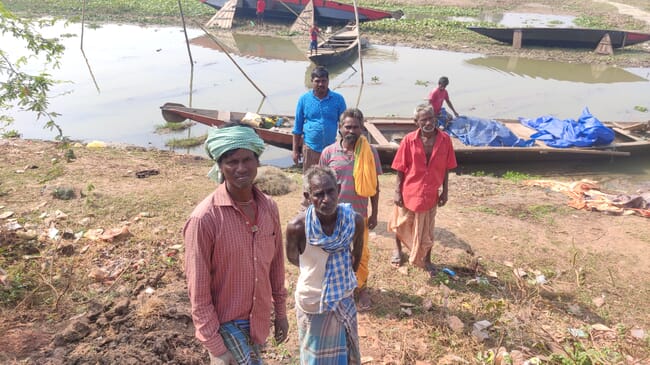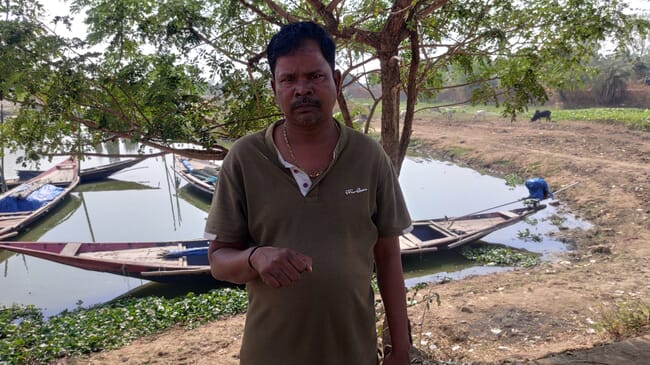
© Gurvinder Singh
For the past five decades, Jogi Behera has been a fisherman on Chilika Lake, the largest coastal lagoon in India and also the largest brackish water lagoon in the world.
The 60-year-old, who lives in Balipatapur, laments that his catch has been dropping with each passing year, due to illegal shrimp farming around the lake.
“The increase in shrimp farming has been snatching our livelihoods and turning us into paupers,” he says. “The catch has been dwindling as the chemical-laced water discharged from the shrimp ponds has been killing the aquatic life of Chilika.”
The lake covers an area of around 1,100km2, which is spread across the districts of Puri, Khurda and Ganjam. Its ecosystem provides large fishery resources and its 300 aquatic species include several threatened ones, such as Irrawaddy dolphins.
“We used to catch around 20-30kg of fish per day, even two decades ago, but now it’s difficult to have 5kg of catch, even after spending several hours in the lake,” says Behera.
“Fishermen will soon migrate to other states if things remain the same,” he adds, while sitting in his ramshackle boat.

© Gurvinder Singh
The rise of illegal shrimp farms
But he is not alone. Over 200,000 fishermen in 132 villages across the Chilika region have been affected – many deeply concerned about their future, in the face of what’s come to be seen as the “prawn mafia”, whose rapid expansion has been devouring their livelihoods. Meanwhile, the authorities seem to have almost turned a blind eye to the plight of the fishing community.
Fishermen claim that mushrooming shrimp farming has already caused grave damage, as several species of native fish, such as Chilika ilish, have almost disappeared.
Large swathes of ponds, mainly producing vannamei shrimp and Bagda shrimp (tiger prawns), have been established around the periphery of the lake.
Farmers are converting their agricultural land into shrimp farming for higher returns, much like in West Bengal.
Odisha has been emerging as one of India’s leading shrimp producers. In 2010-11, the area under shrimp culture stood at 5,324 hectares, but this increased to 13,186 hectares in 2019-20. The production of shrimp rose from 7,520 tonnes to 48,147 tonnes during the same period.
The environmental impact of shrimp effluent
Environmentalists say that the chemical compounds used in shrimp farming have been detrimental to the lake ecosystem.
“Shrimp farming is being done at the periphery of the lake. The farmers use different varieties of chemicals and protein-enriched food for culture of the shrimps. They [shrimp farmers] take the water from the lake and then discharge it back into the lake,” points out Gayatri Devi, an environmentalist and wildlife researcher based in Odisha.
“The chemical- and nutrient-rich discharged water goes into the Chilika water. It results in hyper-nitrification of the wetland water and leads to the growth of vegetation, especially Eichhornia, an exotic invasive species, commonly called water hyacinth. Water hyacinth covers the water surface, destroys the aquatic life, alters the wetland ecology and gradually converts a wetland into a wasteland.”
“Shrimp farming has been affecting the ecology of the most of the wetlands and growth of Eichhornia has been playing a major role in their destruction. The construction of shrimp farms in the buffer of wetland result in the destruction of wetlands and [the loss of] feeding habitat of many migratory and resident birds.”

Shrimp farms have been blamed for the hyper-nitrification of water in the lagoon, which has helped to facilitate the proliferation of water hyacinth, a non-native invasive species. © Gurvinder Singh
Farmland converted to shrimp cultivation
Locals claim that the ponds have been dug illegally for shrimp farming on land that was being used for agriculture.
“During the 1960s, several migrants arrived from different states of India, mostly West Bengal, and settled here. The state government decided to rehabilitate them by offering them land close to Chilika. The land was given on lease to these people. But slowly, the migrants began to sub-lease their land for shrimp farming and shifted to other places,” claims Manoj Kumar Naidu, a senior journalist based in Khurda district.
“Over the years, several acres of land that once belonged to Chilika have been encroached on for shrimp farming and the situation continues to worsen due to the network between the cops, shrimp mafia and administration,” he adds.
Indeed, local activists fighting for the survival of Chilika claim that nothing has been done to save the lagoon, despite the fact that it attracts migratory birds and thousands of tourists each year.
“It’s a losing battle to save the lake, as several letters sent to the Indian President and the Prime Minister’s Office (PMO) have yielded no response so far,” reflects Dilip Kumar Behera, director of the Chilika Fishermen Central Co-operative Society.
“The area of the lake has shrunk to just 580km2 from 1,100 km2 in the past four decades, due to encroachments and siltation. The per-capita income of the fishing community has come down drastically. The population of Irrawaddy dolphins has also dropped to just 60, due to entanglement in gill nets and drag nets. The lockdown has proved to be a blessing in disguise for the shrimp mafia, as the number of ponds has increased in the past few months,” he adds.
Rise in prawn exploitation during lockdown
As well as the encroachment from the ponds, the number of prawn gheris – fine-mesh nets that are staked in the lake to catch prawns and other creatures – has increased drastically during the coronavirus-induced lockdown, claims Dilip.
In 2018, the Odisha government had started a demolition drive and had cleared almost 85 percent of the prawn gheris. Sensing the seriousness of the situation, the government had also re-implemented the Orissa Marine Fishing Regulation Act of 1981, which authorised government officials to clear the illegal gheries.
In February 2020, the state government conceded that the process had stalled. In an affidavit filed in the Orissa High Court a Puri official admitted that no evictions targeting unauthorised operations had been undertaken since November the previous year, when an area of around 268 acres was cleared.
“The collusion of the prawn mafia and the administration has led to proliferation of ponds and bunds. We have complained numerous times to the local administration but no action has been taken yet and their numbers continue to grow,” fumes Surendranath Behera, sarpanch (head) of the Balipatapur gram panchayat (village council) in Khurda district.

Surendranath Behera, sarpanch (head) of the Balipatapur gram panchayat (village council) in Khurda district, has spoken out about the "prawn mafia" © Gurvinder Singh
Human health concern
He also claims that many fishermen have developed allergies from staying in chemical-laced water for extended hours.
“Several fishermen and villagers are suffering from skin rashes, black spots on their bodies and allergies because of the harmful water discharged from shrimp ponds.
“Around 20 people have died of cancer in the neighbouring villages in the past four years… It is not just the fishermen but others are also getting affected, as the water from the shrimp ponds is entering local water bodies and poisoning them where the locals take baths,” says Behera.
Denials
When contacted, senior officials at Chilika Development Authority (CDA) scoffed at allegations of a “prawn mafia” encroaching on the lake periphery.
“We have no such information of illegal prawn farming being done around Chilika. We do regular satellite monitoring along with field visits by our officials to ensure that no illegal activities thrive in the area,” assured Susanta Nanda, chief executive of CDA.




